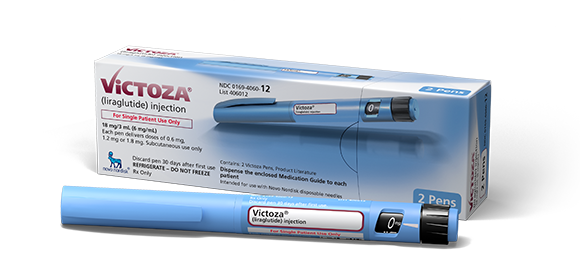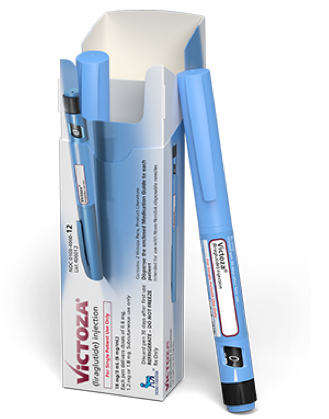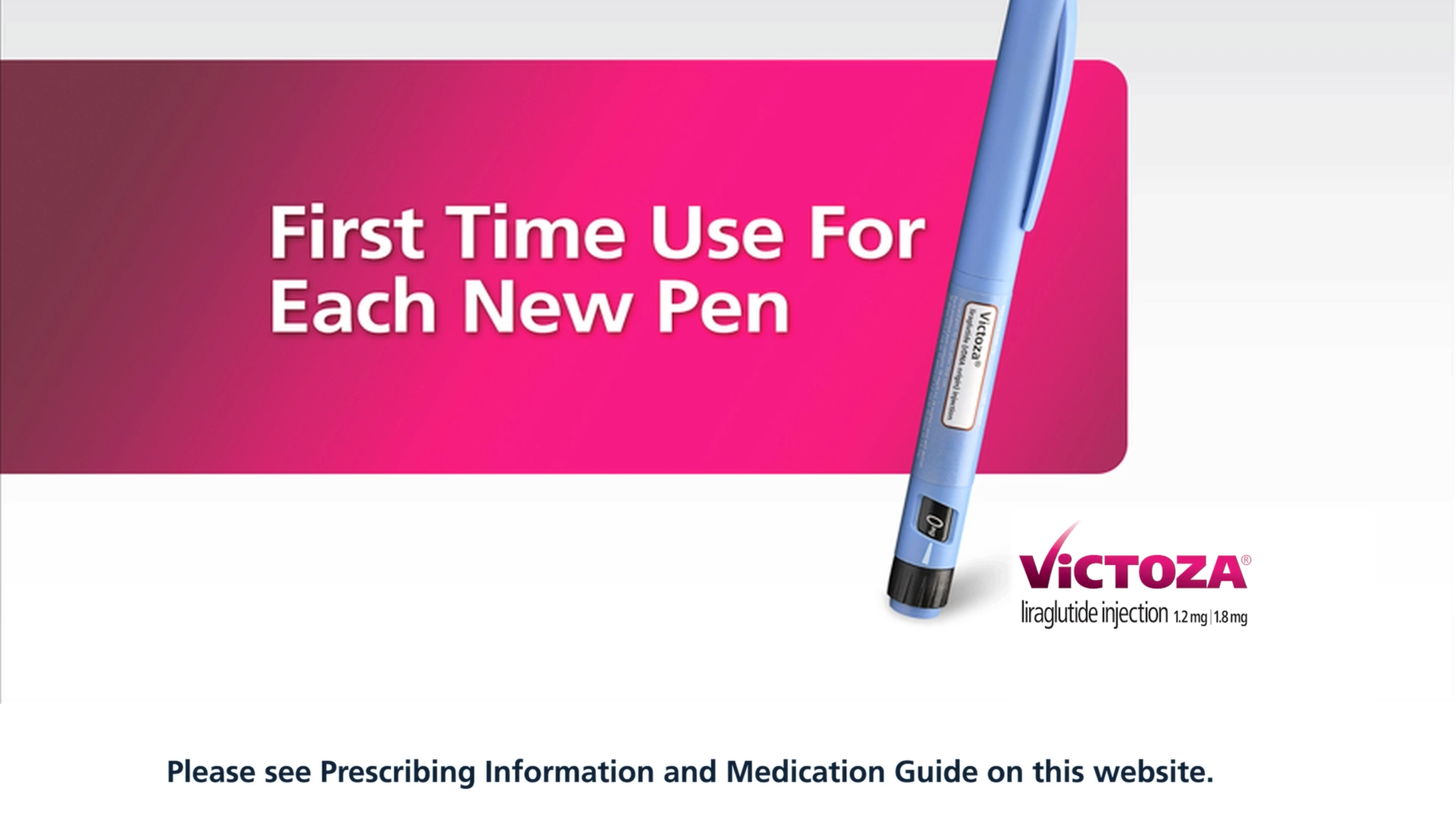How to dose and administer Victoza®

How to start and improve glycemic control for your Victoza® patients
Adult dosing instructions
1. Start
0.6 mg
to improve GI tolerability for at least 1 week1,a
2. Maintain
1.2 mg
for at least 1 week1
3. Titrate
1.8 mg
for further glycemic control1
aThe starting dose of 0.6 mg is a nontherapeutic dose for adults.
How to write a prescription for adult patients in the e-prescribing system
Starting with Victoza®
0.6 mg
Victoza® (18 mg/3 mL)
Sig:
Inject 0.6 mg SC once daily for at least 7 days
Quantity:
6 mL (2-pen box)
Starting with Victoza®
1.2 mg
Victoza® (18 mg/3 mL)
Sig:
Inject 1.2 mg SC once daily for at least 7 days
Quantity:
6 mL (2-pen box)
1.8 mg
Victoza® (18 mg/3 mL)
Sig:
Inject 1.8 mg SC once daily
Quantity:
9 mL (3-pen box)
Pediatric (≥10 years) dosing instructions
1. Start and maintain
0.6 mg
to improve GI tolerability for at least 1 week1
2. Titrate
1.2 mg
if further glycemic control is needed1
Dose may be increased to 1.8 mg if additional glycemic control is needed after at least 1 week of 1.2 mg dose1
How to write a prescription for pediatric patients (≥10 years) in the e-prescribing system
Starting with Victoza®
0.6 mg
Victoza® (18 mg/3 mL)
Sig:
Inject 0.6 mg SC once daily for at least 7 days
Quantity:
6 mL (2-pen box)
If further glycemic control is needed
1.2 mg
Victoza® (18 mg/3 mL)
Sig:
Inject 1.2 mg SC once daily for at least 7 days
Quantity:
6 mL (2-pen box)
If further glycemic control is needed
1.8 mg
Victoza® (18 mg/3 mL)
Sig:
Inject 1.8 mg SC once daily
Quantity:
9 mL (3-pen box)
Information for pharmacists
How to order Victoza® Pens for your pharmacy
Needles are sold separately and may require a prescription in some states.

0.6 mg & 1.2 mg doses
NDC 0169-4060-12
2-pen pack
This is the pen to be given with any NEW START 0.6 mg prescription and to patients using a maintenance dose of 0.6 mg or 1.2 mg.
1.8 mg doses
NDC 0169-4060-13
3-pen pack
Do not dispense these pens unless the patient is taking 1.8 mg a day.
How to store the Victoza® pen
Prior to first use
Refrigerated:
36 °F to 46 °F
(2 °C to 8 °C)
Until experation date1
After first use
Room temperature:
59 °F to 86 °F
(15 °C to 30 °C)
Refrigerated:
36 °F to 46 °F
(2 °C to 8 °C)
For 30 days1
Efficacy and safety for Victoza®
When choosing a treatment for your patients with T2D, review the Victoza® study data.
Support for your patients
Get information on financial assistance and patient access.
Important Safety Information for Victoza®
WARNING: RISK OF THYROID C-CELL TUMORS
- Liraglutide causes dose-dependent and treatment-duration-dependent thyroid C-cell tumors at clinically relevant exposures in both genders of rats and mice. It is unknown whether Victoza® causes thyroid C-cell tumors, including medullary thyroid carcinoma (MTC), in humans, as the human relevance of liraglutide-induced rodent thyroid C-cell tumors has not been determined
- Victoza® is contraindicated in patients with a personal or family history of MTC and in patients with Multiple Endocrine Neoplasia syndrome type 2 (MEN 2). Counsel patients regarding the potential risk for MTC with the use of Victoza® and inform them of symptoms of thyroid tumors (eg, a mass in the neck, dysphagia, dyspnea, persistent hoarseness). Routine monitoring of serum calcitonin or using thyroid ultrasound is of uncertain value for early detection of MTC in patients treated with Victoza®
Indications and Limitations of Use
Victoza® (liraglutide) injection 1.2 mg or 1.8 mg is indicated as an adjunct to diet and exercise to improve glycemic control in adults and pediatric patients aged 10 years and older with type 2 diabetes and to reduce the risk of major adverse cardiovascular events (cardiovascular death, non-fatal myocardial infarction, or non-fatal stroke) in adults with type 2 diabetes and established cardiovascular disease.
- Victoza® should not be used in patients with type 1 diabetes
- Victoza® contains liraglutide and should not be coadministered with other liraglutide-containing products
Important Safety Information cont.
Contraindications
- Victoza® is contraindicated in patients with a personal or family history of MTC or in patients with MEN 2, and in patients with a serious hypersensitivity reaction to liraglutide or to any of the excipients in Victoza®. Serious hypersensitivity reactions including anaphylactic reactions and angioedema have been reported with Victoza®
Warnings and Precautions
- Risk of Thyroid C-cell Tumors: If serum calcitonin is measured and found to be elevated or thyroid nodules are noted on physical examination or neck imaging, the patient should be further evaluated
- Pancreatitis: Acute pancreatitis, including fatal and nonfatal hemorrhagic or necrotizing pancreatitis, has been observed in patients treated with Victoza® postmarketing. Observe patients carefully for signs and symptoms of pancreatitis (persistent severe abdominal pain, sometimes radiating to the back with or without vomiting). If pancreatitis is suspected, Victoza® should promptly be discontinued and appropriate management should be initiated. If pancreatitis is confirmed, Victoza® should not be restarted
- Never Share a Victoza® Pen Between Patients, even if the needle is changed. Pen-sharing poses a risk for transmission of blood-borne pathogens
- Hypoglycemia: Adult patients receiving Victoza® in combination with an insulin secretagogue (eg, sulfonylurea) or insulin may have an increased risk of hypoglycemia, including severe hypoglycemia. In pediatric patients 10 years of age and older, the risk of hypoglycemia was higher with Victoza® regardless of insulin and/or metformin use
- Acute Kidney Injury: Acute renal failure and worsening of chronic renal failure, which may sometimes require hemodialysis, have been reported postmarketing, usually in association with nausea, vomiting, diarrhea, or dehydration. Use caution when initiating or escalating doses of Victoza® in patients with renal impairment
- Hypersensitivity Reactions: There have been postmarketing reports of serious hypersensitivity reactions (e.g., anaphylactic reactions and angioedema) in patients treated with Victoza®. If a hypersensitivity reaction occurs, discontinue Victoza®; treat promptly per standard of care, and monitor until signs and symptoms resolve. Do not use in patients with a previous hypersensitivity reaction to Victoza®. Anaphylaxis and angioedema have been reported with other GLP-1 receptor agonists. Use caution in a patient with a history of anaphylaxis or angioedema with another GLP-1 receptor agonist because it is unknown whether such patients will be predisposed to these reactions with Victoza®
- Acute Gallbladder Disease: Acute events of gallbladder disease such as cholelithiasis or cholecystitis have been reported in GLP-1 receptor agonist trials and postmarketing. In the LEADER trial, 3.1% of Victoza®-treated patients versus 1.9% of placebo-treated patients reported an acute event of gallbladder disease, such as cholelithiasis or cholecystitis. If cholelithiasis is suspected, gallbladder studies and appropriate clinical follow-up are indicated
- Pulmonary Aspiration During General Anesthesia or Deep Sedation: Victoza® delays gastric emptying. There have been rare postmarketing reports of pulmonary aspiration in patients receiving GLP-1 receptor agonists undergoing elective surgeries or procedures requiring general anesthesia or deep sedation who had residual gastric contents despite reported adherence to preoperative fasting recommendations. Instruct patients to inform healthcare providers prior to any planned surgeries or procedures if they are taking Victoza®
Adverse Reactions
- The most common adverse reactions (incidence ≥5%) in clinical trials are nausea, diarrhea, vomiting, decreased appetite, dyspepsia, and constipation
- Immunogenicity-related events, including urticaria, were more common among Victoza®-treated patients (0.8%) than among comparator-treated patients (0.4%) in clinical trials
Drug Interactions
- Victoza® delays gastric emptying and may impact the absorption of concomitantly administered oral medications. Caution should be exercised when oral medications are concomitantly administered with Victoza®
- When initiating Victoza®, consider reducing the dose of concomitantly administered insulin secretagogues (such as sulfonylureas) or insulin to reduce the risk of hypoglycemia
Use in Specific Populations
- The safety and effectiveness of Victoza® have not been established in pediatric patients less than 10 years of age
- Victoza® slows gastric emptying. Victoza® has not been studied in patients with pre-existing gastroparesis
- Victoza® should be used during pregnancy only if the potential benefit justifies the potential risk to the fetus
Please click here for Victoza® Prescribing Information, including Boxed Warning.
Reference:
- Victoza [package insert]. Plainsboro, NJ: Novo Nordisk Inc.
